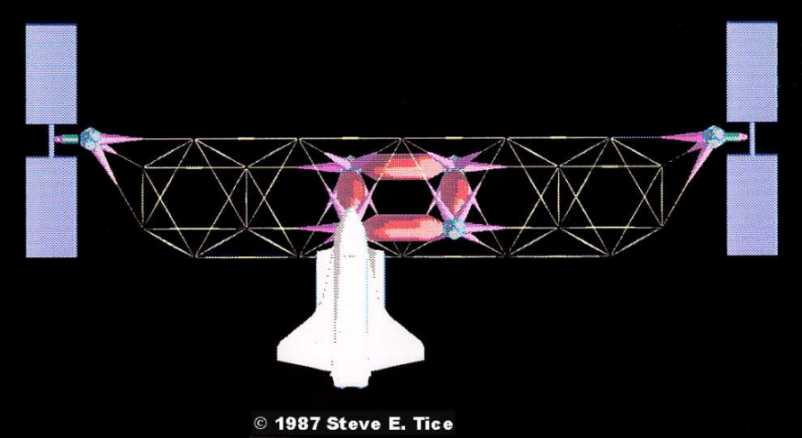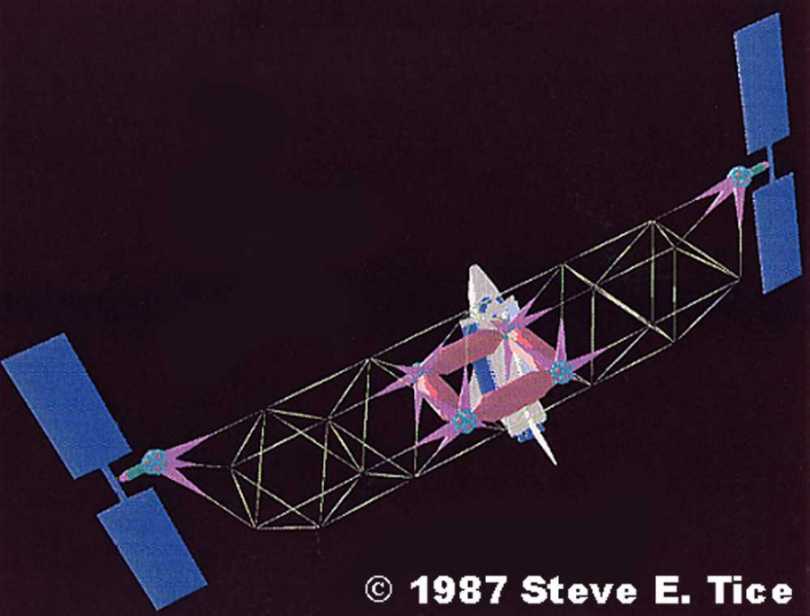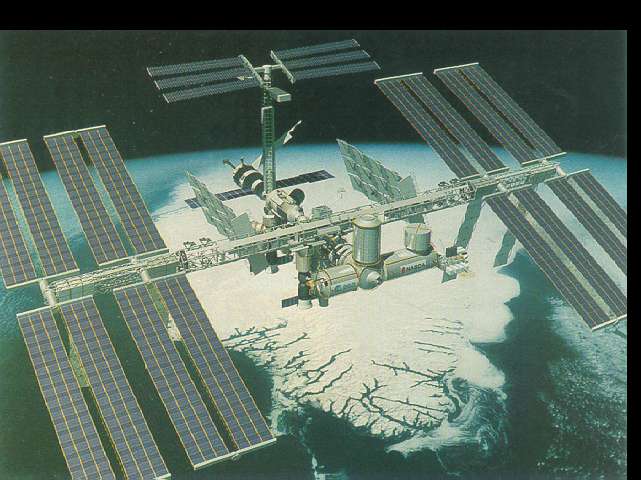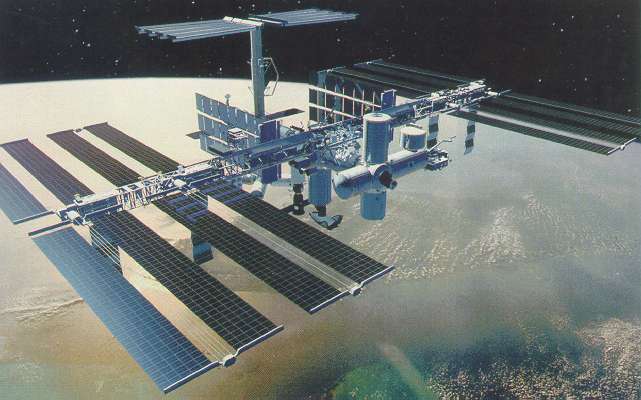
( click above logo to go to company info page )
Protean Space Construction System ( Protean Space Station System )
... invented by Oliver (Ollie) P. Harwood in 1984 for application to the NASA managed post Skylab International Space Station development effort, now being applied to create a new soon to be released toy construction system product ...
"... A Space Structures Construction System and Architectural Design Philosophy (not a specific configuration, like today's over budget, behind schedule, special-case engineered orbiting Space Station), formally rejected by NASA in 1986. If employed by NASA's manned space flight effort, this design and philosophy would have provided the world with a more robust, usable and truly re-configurable "maintainable foothold into Space", much earlier in time and saved the U.S. Tax payers billions of dollars; which could have been made available for furthering manned space exploration and spacecraft research/development ... now our dreams of aggressive space exploration in our lifetimes are dashed. At least if a toy product is created from this elegant design and design philosophy, maybe the bureaucrats, scientists and engineers of the future will see it's merit and apply it to real world future projects for space exploration; ... in general we are great supporters of NASA's work and successes, especially in un-manned space flight (who could teach NASA's manned management folks something about optimal cost-effective system design), we just want them to realize that it is time to start doing the right thing when it comes to taxpayers hard earned money and dreams of the young and old ..." (former Space Station Design Engineers and Rockwell International Space Systems engineers, 1987)
The Space Station That Never Was: A More Rational and Flexible Design Rejected By NASA
by Alan B. Scrivener
In the mid-1980s while NASA was selecting the contractors for the first American space station -- which later became the International Space Station (ISS) -- aerospace engineer Oliver "Ollie" Harwood at Rockwell Space Systems, Space Station Division in Downey, California, proposed an alternative design. It was based on the octet truss, one of the triangular structures invented by Buckminster "Bucky" Fuller. It's key features were it's flexibility and structural stability, unlike the rectangular configured station then being considered and now being built. It was called the "Protean" design because of this inherent change-ability. NASA rejected the alternative design and for a while actively persecuted Ollie and his engineering supporters for continuing to promote it. Several members of the 3D graphics community in Los Angeles, some former Rockwell Spacecraft designers, joined together with Ollie to design mission compatible Space Station designs based on Ollie's Protean system and make computer renderings and animations to help explain Ollie's construction system for Congressional testimony. For a while the Protean Space Station ( aka Proteus Space Station System ) was championed by former U.S. Senator William Proximire, and ex-astronauts Buzz Aldrin and John Glenn.
Additional trade and newspaper articles, and trade conference papers regarding the Protean Space Construction System are located at: ABS Archive
Click below for access to the full text of the 1985 Harwood paper published in the Journal of the British Interplanetary Society
Space Station Configuration Designs depicted below, applying the Protean Construction System ( Proteus or Protean Space Station System ) and Design Philosophy, developed by Rockwell International Spacecraft Designers, Benjamin C. Thompson (now at Boeing Aerospace) and Steve E. Tice (formerly Spacecraft Designer and Supervisor, Advanced Design Simulation lab of Rockwell International Space Systems and Space Station divisions, now at QuantumWorks Corporation)


Protean Space Construction System and Related NASA Space Station Chronology (DRAFT version - revisions in work)
|
Feb-May 14, 1973 |
Dr. Robert R. Meyer lead with O.P. Harwood contributor to NASA CR 124075 : Isogrid Design Handbook, McDonnell Douglas Astronautics Company, USA, Feb. 1973 - https://femci.gsfc.nasa.gov/isogrid/NASA-CR-124075_Isogrid_Design.pdf Ollie P. Harwood working with Dr. Robert R. Meyer lead Structural Design on SKYLAB. https://www.jsc.nasa.gov/history/skylab.htm |
|
June, 20, 1973 |
"ISOGRID" paper - R.R Meyer (1973). Isogrid - A Simple, Efficient, Stiffening Concept, AIAA/ASME/SAE 14th Structures, Structural Dynamics and Materials Conference, AIAA Paper No. 73-365. |
|
May 1982 |
NASA regarded a permanently manned space station as the next “logical step” in manned space flight after the Space Shuttle entered service in April 1981. The agency formed a Space Station Task Force in May 1982 to study possible user requirements. |
|
August 1982 |
NASA awarded eight $1-million study contracts to Boeing, McDonnell-Douglas, TRW, Rockwell International (RI), Grumman, General Dynamics/Convair and Martin Marietta. The contractors reported back in March 1983. http://www.astronautix.com/s/spacestationdesigns-1982.html |
|
Feb - May, 1884 |
O.P. Harwood, senior design engineer, submits Rockwell International (RI) Internal Letters (ILs) documenting his evolutionary "Protean Space Construction System (SCS)" with 6 basic design elements, which can be configured to satisfy all presented justifiable NASA operational mission space station requirements. Mentoring new Designer hire S.E.Tice 1982-1984, a few CAD concepts on Rockwell's CDS system are created (In 1987 they were updated and developed in CAD, as shown above) By this time S.E.Tice led the development of a derivative CAD/CAE/Simulation system which unfortunately was not used to simulate assembly operations of the PROTEAN SPACE STATION design. |
|
Oct. 1984 |
O.P. Harwood publishes pre-JBIS "un-cut" version of paper of the same name - "An Evolutionary Space Station Architecture" - http://old.quantumworks.com/jbis_article.htm |
|
April, 1985 |
During the NASA Phase B studies, NASA radically changed its Space Station baseline design in October 1985 following "frequent complaints from users and astronauts". The new "Dual Keel" Station was largely based on Lockheed and McDonnell-Douglas designs and its structure was "much stiffer and hence easier to stabilize" (still awful from structures and assembly perspectives). It would offer additional space for external instruments plus a better micro-gravity environment than the previous gravity gradient-stabilized "Power Tower.” The number of crew members was increased to 8 astronauts because scientists were concerned that a crew of six would be too busy with assembly & maintenance tasks and have no time for research. NASA submitted "design" for Space Station during Phase B was reviewed by potential Space Station contractors - "the un-spoken word was actually that their will be no design competition - cost, operations, management, politics, etc. based proposals only - NASA themselves does the configuration designing. Rockwell’s “Dual Keel” proposal (version of NASA suggestions) would require 11 Shuttle flights for initial assembly. Officially, the estimated cost of the Station had only increased by $400 million but there were concerns that NASA was once again hiding the true cost of the larger, more complex “Dual Keel” design. Diagram published by NASA shows the distribution of work between the four NASA centers and international partners during Phase B in April 1985-87. http://www.astronautix.com/s/spacestation1984.html Ollie P. Harwood submits totally objective critique of NASA's Phase B "submitted or suggested designs" to RI management. |
|
July, 1985 |
"An Evolutionary Space Station Architecture" by O.P.Harwood is published in the Journal of the British Interplanetary Society (JBIS) |
|
|
RI Engineer, member of the "Protean SCS group", John Krieter writes to Senator John Glenn. As a result, Senator John Glenn forwards materials with his support of O.P. Harwood SCS architectural system, to NASA - JSC |
|
Jan. 9, 1986 |
Following an apparently flawless launch, carrying seven crew members, including high school teacher Christa McAuliffe, the space shuttle Challenger lifts off Tuesday, January 28 -- without warning, a catastrophic explosion that blew apart the NASA space shuttle Challenger 74 seconds after lift-off. There are no survivors. Rogers Commission investigates. |
|
Jan. 27, 1986 |
NASA, John F. Murphy, responds formally to Senator John Glenn Protean SCS support letter to NASA-JSC -- in affect formally rejecting the Protean SCS architecture |
|
March 1986 |
NASA struggled to define a “Dual Keel” design that met all the various cost, engineering, safety, launch and user requirements. By the time Phase B1 ended in March 1986, the size of the truss structure elements had been increased from 3 x 3 meters to 5 x 5 meters for additional strength and stiffness (again making up for an inadequate design from the start as O.P.Harwood documented to RI management). |
|
??? |
U.S. National Research Council (NRC) forced to review Protean SCS. Aerospace Corporation review of Protean SCS architecture |
|
May - Oct. 1986 |
NASA Space Station Office submitted its recommended final baseline design in May 1986 as Phase C/D started. The “Dual Keel” Space Station’s final flight sequence overview in October 1986 had to insert an additional eight Shuttle flights into the manifest. By this time, increased complexity and Shuttle payload capability reductions had increased the required number of assembly flights to more than 30 for an Initial Operating Capability (IOC) vs. 8-10 in 1984. NASA’s new Space Station design was criticized in a widely publicized astronaut office briefing by Shuttle astronaut Gordon Fullerton. The Dual Keel design was found to provide poor access for maintenance, visibility from habitable areas was obstructed, there was no provision for internal vehicle 'hands on' access to EVA equipment. No crew escape vehicle had been added although a small fleet plus lower-than-hoped-for flight rates means astronauts could not be rescued as easily by the Shuttle. The Canadian manipulator was regarded as insufficient for building and maintaining such a complex Station. Fullerton also criticized excessive EVA "spacewalk" requirements, including a "long and complex" assembly sequence. "Basic structure, wire runs, and plumbing are not easily designed for replacement / repair. EVA crew time even for planned maintenance is excessive. Correction of design errors may not be possible; unplanned failures may not be fixable at all..." The Space Station was briefly suspended by a major row in the summer of 1986 when NASA tried to reassign some habitation module responsibilities from the Johnson Space Center to the Marshall Space Flight Center. A compromise was reached in September 1986, but it was yet another indication of the Station’s byzantine management structure and turf battles between NASA centers. But Congress still approved the project’s $420-million Fiscal 1987 budget while imposing a number of restriction: power levels of at least 37.5KW, fully outfit the microgravity lab by the sixth assembly flight, attach useful science payload by the third flight, launch all US elements before the foreign modules and restrict ESA's Columbus module to life sciences. The congressional requirements would essentially have forced NASA to change the Station along the lines of a new proposal which then, surprisingly, emerged from JSC. NASA had previously testified in Congress that no Station funds were being spent on alternative design studies. Using funding earmarked for alternate assembly sequence research, the Johnson Space Center nonetheless ordered its main contractors (Rockwell and McDonnell-Douglas) to examine a smaller, more compact configuration while keeping NASA headquarters in the dark about it... This caused additional confusion about who was really in charge of the project: NASA headquarters or Johnson. |
|
April 26, 1987 |
Front page L.A.Times article by Lee Dye first reveals the fiasco with the NASA Space Station design competition, it's management and the potentially superior design submitted "outside of RI", by O.P.Harwood and the Proteus group, made up of RI engineers, and discarded by NASA |
|
May 8, 1987 |
After members of Protean group were being reprimanded by RI management, Lee Dye publishes another front page L.A.Times article "RI Engineers Warned over Criticism". (copies located at: ABS Archive |
|
May 20, 1987 ? |
Protean group prepares visuals and presentation and OPHarwood testifies to the Senate Appropriations Committee in Washington D.C. |
|
June 2, 1987 and August 27, 1987 |
Then Senator William Proxmire of Wisconsin sends letter to Dr. Robert Seamans, Chairman of NRC Committee on Space Station urging that they take a "serious look" at the Protean Space Construction System. As a result of "political" response to Proxmire's and others urging, in August, Proxmire releases a press release requesting that the Space Station project being "killed as it is currently configured". (copies located at: ABS Archive |
|
September 1987 |
O.P.Harwood retires from RI (Rockwell International) Space Systems Division, Downey |
|
December 1987 |
Despite all the problems, the Space Station plan was approved (with reservations) by a National Research Council panel in September 1987, finally clearing the way for NASA to award Phase C/D development contracts in December. The combined value of all four Phase C/D Work Packages was over $5 billion. By 1986-87 it was becoming increasingly obvious that there would be no major market for commercial space manufacturing on the Space Station. When President Reagan approved the project in 1984, some analysts forecasted the space manufacturing business would be worth up to $20 billion per year in 2000. The projections turned out to be overly optimistic, in part because the 1986 Challenger accident greatly increased the commercial cost of Space Shuttle missions while reducing the number of flight opportunities. |
|
June 1988 |
NASA’s first detailed cost assessment in February 1987 revealed the “Dual Keel” Space Station would cost at least $14.5 billion in 1984 dollars, or $21 billion in current-year dollars. This caused a political uproar in Congress, where many politicians had started to express doubt about the project. However, NASA and Reagan Administration officials reached a compromise in March 1987 which allowed the agency to proceed with a cheaper $12.2-billion Phase One Station (1984 dollars; $17.7B in current-year dollars) that could be completed after 10 or 11 Shuttle assembly flights. Annual funding levels would be: $767 million in FY 1988, $1.4 billion in FY 1989 & 1990, $2.3 billion for the next three years and $1.4 billion in FY 1994. This design initially omitted the $3.4-billion “Dual Keel” structure and half of the power generators. The new Space Station configuration was named “Freedom” by Reagan in June 1988. The Space Station “Freedom” assembly sequence (1988). NASA tried to reduce the number of Shuttle assembly flights by making several modifications. The first launch would now take place in March 1994, the Station would be permanently manned from April 1995 onwards and be completed in March 1997 after 17 flights. Congress disliked the 6-9 month delay and briefly demanded that the schedule be accelerated. Illustrated here is the 1988 baseline, which stretched the assembly sequence by one year due to unexpected budget reductions. As always, considerable political filling and sanding was required since the Lewis and Goddard Spaceflight Center-led Work Packages mostly involved “Dual Keel” elements that now were postponed indefinitely |
|
October 17, 1988 |
O.P.Harwood letter "Space Station Realities" published in Aviation Weekly and Space Technology trade magazine stirs support from community |
|
December 7, 1987 |
Former astronaut, second man on the moon, Buzz Aldrin shows
support for Protean SCS ( Proteus Space Station System ) ... and speak out to support Protean station effort. Aviation Week & Space Technology trade magazine reports on the Protean SCS and the current faulty NASA station design process. (copies located at: ABS Archive |
|
February 1989 |
O.P.Harwood and the Protean group send REPEAT letters "that something needs to be done immediately", to U.S. Senator Barbara Mikulski, Representative Robert Traxler, Senator Al Gore, Appropriations Committee of U.S. House of Representatives, former U.S. Senator William Proxmire, etc. |
|
March 1989 |
Senator and Representatives responses to O.P.Harwood and group were mostly "form letters" which did not acknowledge any of the publicly known Congress vs. NASA frustrations with Space Station funding and designs. However, response from William Proxmire was most favorable, "wishes he was still in U.S. Senate so he could do something about the philosophical and technical mis-steps of NASA on the Station project. During William Proxmire's, lengthy career as a Democrat from Wisconsin, the otherwise liberal, was an outspoken opponent of government waste, famous for the "Golden Fleece" awards he bestowed on what he considered particularly egregious sins against the taxpayers. The Station project by this time certainly was eligible for such an award. |
|
March 1991 |
The Space Station Freedom project finally collapsed under its own weight in 1990, when the design was found to be 23% overweight, over budget, too complicated to assemble while providing 34% too little power for its users. A NASA panel led by Bill Fisher and Charles Price then discovered that 2,282-3,276 hours of EVA “spacewalks” would be required per year vs. NASA’s goal of 500 EVA hours/year ... Congress consequently demanded yet another redesign in October 1990 while requesting further cost reductions as the Fiscal 1991 budget was cut from $2.5 billion to $1.9 billion; the overall budget cut will be $6 billion over five years. NASA unveiled its new Space Station design in March 1991. The resulting new configuration was mockingly referred to as “Fred” by the programs critics, underscoring the truncated nature of the design. The redesigned Space Station would have required a total of 23 Shuttle launches vs. about 29 for the previous configuration. The first launch was now scheduled for November 1995 and the Station would be permanently manned in September 1999 after 17 Shuttle flights. |
|
May 1991 - June 1993 |
The Sun sets on the Space Station “Fred” project. Although the 1991 redesign greatly enhanced NASA’s capability to actually build and launch the Space Station, the project continued to be unpopular with politicians and scientists. In May 1991, a House Appropriations subcommittee voted to terminate the project although the full House of Representatives reversed the decision a month later. The project received its full $2.03-billion Fiscal 1992 budget, but only after some other NASA projects were cancelled. The Station dodged another bullet in August 1992 when an amendment to cancel the project failed, 181-237. NASA then had to absorb a $150-million Space Station budget reduction in Fiscal 1993 as the project entered its early flight hardware production phase. NASA was now forced to slip the first launch by four months into 1996 while the man-tended Space Station operations phase would be delayed by six months. The capability to support a permanent crew was delayed by nine months. The end of the Cold War lead to calls for reduced spending on defense and space programs. Following reports of new cost overruns of $1 billion in Fiscal 1993-95, the new Clinton Administration finally ordered a new redesign in March 1993... NASA was to provide three alternatives costing $5,$7 and $9 billion (Fiscal 1994-98) by June 1993. The important objectives were: maintain international commitments, advance the date for Permanent Manned Capability to 1998, preserve as much previously designed hardware and growth potential as possible while meeting minimum life science & microgravity objectives, cut astronaut EVA requirements, flight, mission operations and logistics by 50%, and streamline technical and program management. President Clinton’s endorsement of the new Option A Space Station did little to help the project. The “compromise option” eventually chosen by Clinton was Option A. Like Option B, this configuration was based on the abandoned Space Station Freedom design from 1991, so it was more acceptable to the international partners than Option C. Option A would start with a "power station" to which an extended duration Shuttle could dock for initial research lasting 20 days at most. Lockheed's “Bus-1” (a previously classified US Air Force spacecraft) would provide propulsion and attitude control. The US laboratory and node would also be integrated into a single module. In June 1993, a bid in Congress to kill the Station failed by a single vote (215-216). Scientists continued to be critical of the project, saying its benefits were more marginal than ever after the latest redesign and that the Station had lost its political mission too following the end of the Cold War. |
|
August 1993 |
Aerospace mergers plus increased emphasis on commercial space
made it easier for the new NASA Administrator, Dan Goldin, to reform the Space Station and NASA in general. The
Space Station Program Office in Reston, Virginia was cancelled (finally) as NASA selected Boeing (which bought
the space divisions of other Station contractors such as McDonnell-Douglas and Rockwell in the 1990s) as the new
Station prime contractor. Boeing's contract from 1995 contained less NASA oversight (too much damage done
already) than usual while giving the company and its Space Station "integrated production teams" some
financial rewards in case the projected goals are met. The Johnson Space Center now hosts the Station's new program
office. All this has greatly simplified the project’s cumbersome management structure, although the efforts to
avoid cost overruns and delays still have not been entirely successful. Brazil joined the ISS project in 1999 and
China may become a partner in the future. The International Space Station, the largest and most complex structure ever placed in orbit, would provide more than 46,000 cubic feet of pressurized living and working space, roughly equivalent to the passenger cabin volume of two 747 jetliners. Technologically, ISS reverses the continuing trend (since 1986) toward a smaller and less capable Station. The new configuration reintroduced the US laboratory and node module into the design. ISS will have more science racks than Freedom and provide more power for experiments. The total mass in orbit is 370 metric tons, so the International Space Station weighs almost twice as much as Space Station Freedom. A big plus according to NASA was the Station now could be manned almost immediately as soon as the Russian FGB and Service Modules had been launched. In contrast, Space Station Freedom would not have been capable of supporting a permanent crew before a dozen or so modules had been launched. |
|
September 1993 |
In September, NASA presented Clinton with two final options: the small 4-man US-only “Alpha” Station approved in June or the larger and much more capable 6-crew “Russian Alpha” design shown above. President Clinton chose the latter option, essentially merging the American SS Freedom and Russian “Mir-2” projects into a new International Space Station (ISS). The President also managed to strike a deal with Congress which established a fixed annual budget of $2.1 billion. The agreement has been remarkably successful; the last attempt to cancel the project was rejected in the House of Representatives in 1994 |
|
August-September 1997 |
Boeing, with its new North American component from Rockwell International Corp.’s defense and space units, merged with the McDonnell Douglas Corporation. Congressional criticism of NASA's Space Station program continued https://www.gao.gov/assets/230/224685.pdf http://articles.latimes.com/1998/feb/15/news/mn-20296 |
|
Present |
Oliver P Harwood was born on September 30, 1922. He died on June 2, 2003
at age 80. Oliver P Harwood had been residing in Huntington Beach,
Orange County, California.
The current International Space Station shown below will be
completed by 2006 at the earliest which translates to a cost increase of at least $6 billion over the initial $19.4-billion
estimate from 1993. However, the project now seems to have careened past most of its obstacles since the two crucial
Russian modules -- Zarya and Zvezda -- were launched successfully. Recent minor modifications include a centrifuge
module for biological experiments (provided by the Japanese) plus some changes to the Russian laboratory modules |


For more Protean SCS related pictures and information, please click on ABS Archive
For more information or input to this web page, or corrections, or information related to the Protean SCS ( Proteus Space Station System ) related toy product project and investor information, please contact Steve at info@quantumworks.com